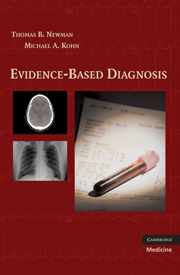Book contents
- Frontmatter
- Contents
- Preface
- Acknowledgments & Dedication
- Abbreviations/Acronyms
- 1 Introduction: understanding diagnosis and diagnostic testing
- 2 Reliability and measurement error
- 3 Dichotomous tests
- 4 Multilevel and continuous tests
- 5 Critical appraisal of studies of diagnostic tests
- 6 Screening tests
- 7 Prognostic tests and studies
- 8 Multiple tests and multivariable decision rules
- 9 Quantifying treatment effects using randomized trials
- 10 Alternatives to randomized trials for estimating treatment effects
- 11 Understanding P-values and confidence intervals
- 12 Challenges for evidence-based diagnosis
- Answers to problems
- Index
- References
4 - Multilevel and continuous tests
Published online by Cambridge University Press: 04 August 2010
- Frontmatter
- Contents
- Preface
- Acknowledgments & Dedication
- Abbreviations/Acronyms
- 1 Introduction: understanding diagnosis and diagnostic testing
- 2 Reliability and measurement error
- 3 Dichotomous tests
- 4 Multilevel and continuous tests
- 5 Critical appraisal of studies of diagnostic tests
- 6 Screening tests
- 7 Prognostic tests and studies
- 8 Multiple tests and multivariable decision rules
- 9 Quantifying treatment effects using randomized trials
- 10 Alternatives to randomized trials for estimating treatment effects
- 11 Understanding P-values and confidence intervals
- 12 Challenges for evidence-based diagnosis
- Answers to problems
- Index
- References
Summary
Introduction
To this point, we have discussed the accuracy of dichotomous tests – those that are either positive or negative for the disease in question. Now, we want to consider the accuracy of tests with more than two possible results. As discussed in Chapter 2, the results of such tests can be ordinal (if they have an intrinsic ordering, like a Gleason score for pathologic grade of prostate cancer) or nominal (if they do not, such as a blood type). Ordinal variables can be discrete (having a limited number of possible results, like the Gleason score) or continuous, with an essentially infinite range of possibilities (like a serum cholesterol level or white blood cell count). In this chapter, we discuss how making a multilevel or continuous test dichotomous, by choosing a fixed cut-off to divide “positive” from “negative,” reduces the value of the test. We also introduce the Receiver Operating Characteristic (ROC) curve used to summarize a multilevel test's ability to discriminate between patients with and without the disease in question. In evaluating a patient, we must use the patient's test result to update his or her pre-test probability of disease. In Chapter 3, we learned the 2 × 2 table method for probability updating, but it only applies to dichotomous tests. The LR method will be more useful now that we have moved to tests with more than two results.
- Type
- Chapter
- Information
- Evidence-Based Diagnosis , pp. 68 - 93Publisher: Cambridge University PressPrint publication year: 2009
References
- 4
- Cited by



